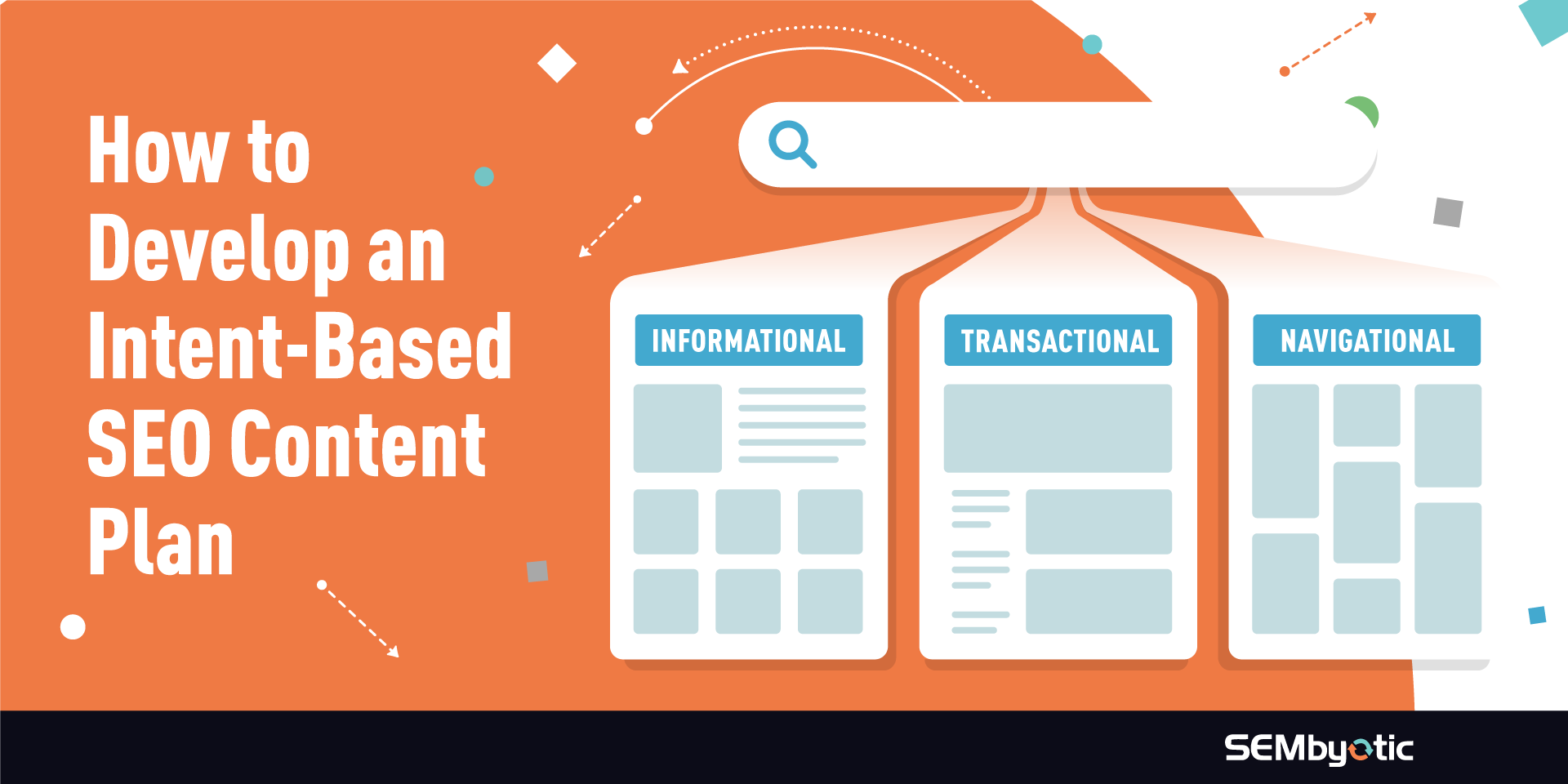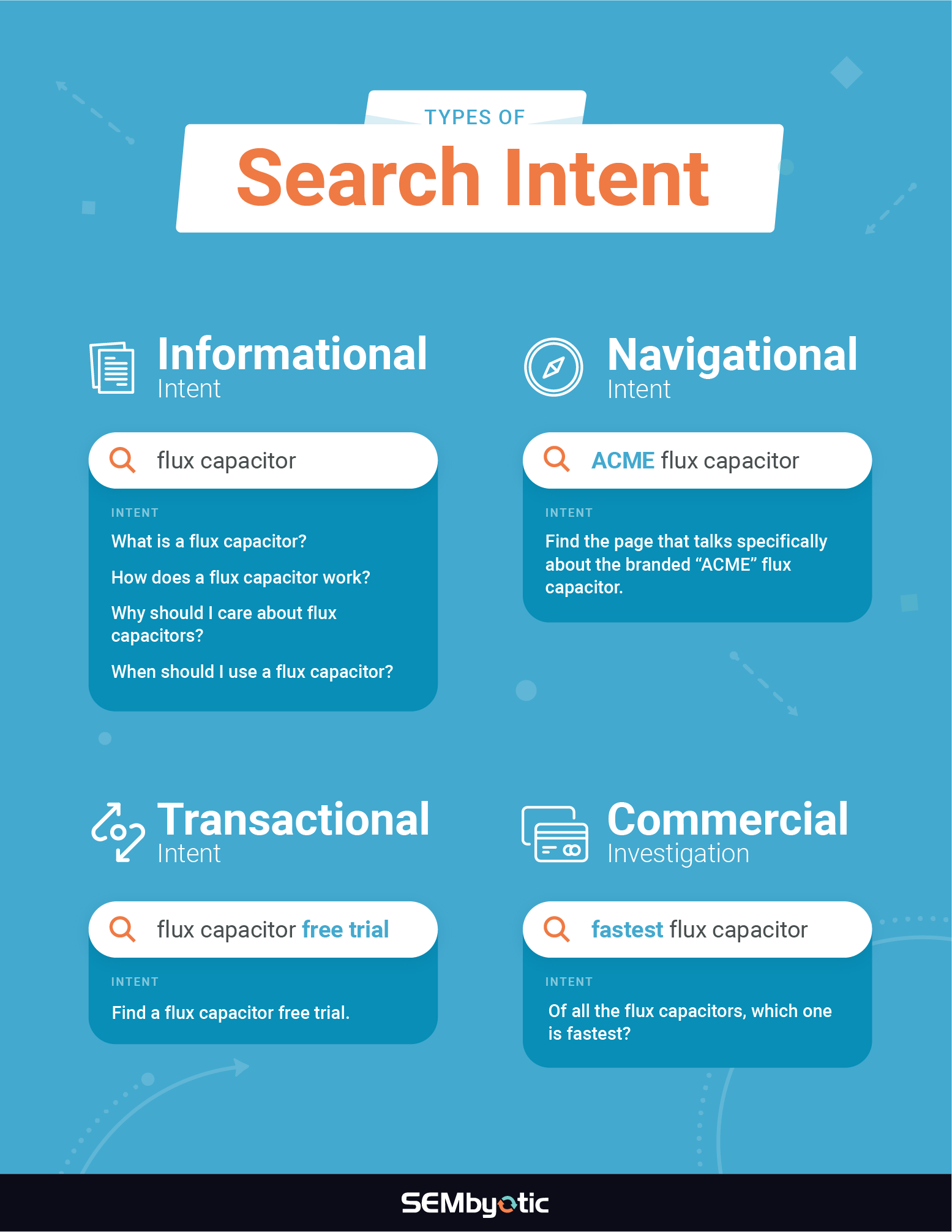
How to Develop a Search Intent SEO Content Plan
Broadly speaking, a person using a search engine to mine the web for information is looking to go somewhere, know something, do something, or buy something. These are all examples of search intent or keyword intent.
Your customers and potential leads will likely have different search intentions and goals at various stages of your sales funnel. Understanding this search intent behavior and optimizing your content for search intent is critical to a successful SEO strategy and your digital marketing flywheel.
Types of search intent:
- Informational intent – People looking for information on a topic. These are often more broadly searched keywords. The opportunity here is to demonstrate thought-leadership, boost brand reputation, and generate traffic from those attempting to educate themselves.
- Navigational intent – People trying to find a specific website. This intent is commonly served by your branded keywords.
- Transactional intent – People that have the intention of buying something, downloading something, or taking the steps to take one of those actions.
- Commercial investigation – People doing research on products/solutions, potentially with the intent to buy/download in the near future.

ADD THIS INFOGRAPHIC TO YOUR SITE:
<a href="https://sembyotic.com/blog/how-to-develop-a-search-intent-seo-content-plan/"><img style="width: 100%;" src="https://sembyotic.com/wp-content/uploads/sembyotic-blog-post-infographic-1.png" /></a> View this on the SEMbyotic blog: <a href="https://sembyotic.com/how-to-develop-a-search-intent-seo-content-plan/">SEO search intent</a>
The Goal of an Intent-Based SEO Content Plan: Match Intent with Keywords and Content
At its core, the goal of a search intent SEO content plan is to present your site visitor with the appropriate content that matches their intended search results. The objective is to create opportunities to accelerate visitors into the marketing funnel by presenting related content on landing pages originating from various intents. For example:
A person searches for “what is a flux capacitor?” and finds an informational page about flux capacitors. On that page, offer an asset (Flux Capacitor White Paper) to encourage the first contact, or encourage them to pursue commercial investigation by way of reviewing a Flux Capacitor Case Study page.
Search Intent Query Examples
Informational Intent
“what is a flux capacitor?” or just “flux capacitor”
While it’s possible that this person may ultimately be looking for a commercial solution, this particular search intent is to learn more about the phrase “flux capacitor”. Search engines will present content that is informational, typically from sites that are considered trusted authorities on said topics (e.g., Wikipedia, TechTarget, etc.)
SEO Content Strategy
Provide a page that attempts to be an unbiased authority on “flux capacitors.” This page should be informational in nature. It should describe what it is, what it does, when it should be implemented, its shortcomings, its strengths, etc. Since you’ll own the content you can control the conclusions you want your readers to draw.
Note
If you want to rank near the top for most non-branded keywords, you should start by having a look at what ranks now. Your goal should be to create content that offers more depth and detail than whatever ranks before you start. If you don’t think you can reasonably create better content, it’s worth rethinking whether or not you want to focus on that keyword. Read the post about how to 10X your content to get ideas for how you can be the best content on the web for a given topic.
Tips for Optimizing Content to Address Informational Search Intent:
- Use visuals alongside your copy. Visuals will help you to get indexed within image searches along with text searches. They’ll also make your content more amplification-worthy because people tend to share pages with strong visuals more frequently.
- Leverage HTML5 image caption markup. There’s a decent chance that the ONLY content many people will read on your blog is the title, headers, and captions, so make them meaningful!
- For non-branded topics, consider making your visuals non-branded. Otherwise, your visuals will appear to be only applicable to your own solutions.
- Try to be the best source on the web for this topic. Look at what currently ranks and make sure your content is better.
- Add lead generation assets or calls to action (CTAs) in prominent locations on these pages. Those assets should be somewhat related to the topic.
- Present your solution use-cases or other applicable content to encourage visitors to learn how your company, product, or solution might solve their problems or how it applies to this informational query. In other words, transition the visitor into a commercial investigation phase.
Navigational Intent
“ACME flux capacitor”
This person is most likely looking for the page for your branded product or solution.
SEO Content Strategy
Branded search is a place that you should win most of the time with little effort. Google and other search engines will place a lot of authority upon your site for your own brand. These types of searches will likely be a lower priority as a content strategy. As long as your site is well-structured and doesn’t put up any technical roadblocks, you should be good here.
Transactional Intent
“order an ACME flux capacitor”
This person wants to find the link to download information on your product, service, or solution.
SEO Content Strategy
A solid plan to address these types of searches is similar to Navigational Intent. As long as your pages are well-structured and clear, Google and other search engines will easily find the appropriate pages for these terms.
Commercial Investigation
Commercial investigation keywords are those that indicate that a person is in research mode. Common examples include modifiers such as “best”, “fastest”, “cheapest”, “top”, “most popular”, etc. For example:
“fastest flux capacitor”
The addition of the word “fastest” – or any additional adjective – changes the intent for this search query because now the visitor intends to find which solution is fastest, best, cheapest, etc. There is an intent to purchase either immediately or in the future.
SEO Content Strategy
Optimize your pages for the full commercial investigation query “fastest flux capacitor” but only if this is a true statement or valid claim. Your customers and competitors will likely be able to verify your claims online through third-party reviews and other sources. But if you can tout that your product, service, or solution is the best, fastest, etc, then your page title tags, meta descriptions, and content should reference this fact and should provide the proof by way of benchmarks.
Bonus Tip
Industry analyst websites or blogs lean more heavily on commercial investigation keywords because they create roundups and reviews to educate people on which “flux capacitor” is the best, fastest, cheapest, etc. Those third-party sites will often have a better chance at ranking than yours for these keywords, but it’s important to consider strategies that place your content in front of these bloggers and analysts so that your product or service is part of the conversation. Consider creating content that showcases how your product is the best, fastest, cheapest, etc., then plan a paid social influencer campaign to place your content in front of those influencers.
Applying a Search Intent Content Strategy to the Whole Site
Prioritize your overall content strategy around informational intent and commercial investigation intent searches. Here are some ideas for extending a search intent-based content strategy across your whole site:
Provide Informational Resources
Develop an “Education Center” or glossary of terms related to your business. Priority should be placed on phrases that are the most relevant to your business and/or where you have the most opportunity. Look for low-hanging fruit, where content for given terms is underserved on Google. Your job here is to educate people about matters related to your business, but not necessarily about your own specific products and/or services.
Leverage Your Blog
One of the benefits of a blog is that it can service almost any search intent based on the subject matter of a given post. Google has stated within its quality guidelines that Experience, Authority, and Trust (EAT) are ranking factors. Your blog is the perfect vehicle for demonstrating this.
Addressing Search Intent and Filling Content Gaps Adds Value
The extra effort of developing a search intent-based content plan will pay off over the long run. Rewarding intent-based searches with relevant content helps to build experience, authority, and trust (EAT) that can pay dividends as your visitors move through their buyers’ journey toward making a purchasing decision. It will also help organically drive better quality leads through your sales funnel.
Need help? Contact us at SEMbyotic to perform an SEO audit, develop an SEO content strategy, and execute on a strategic content plan.